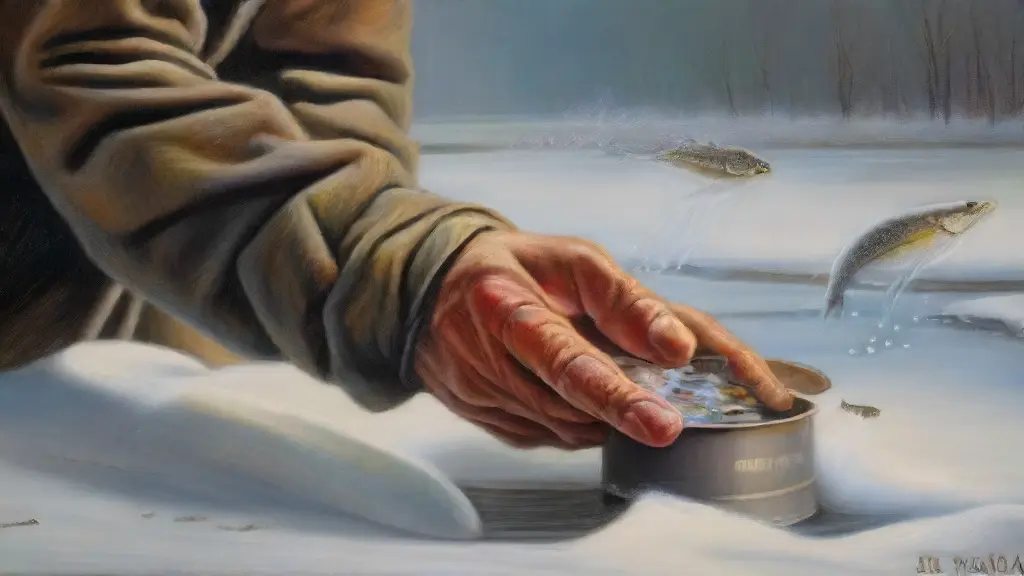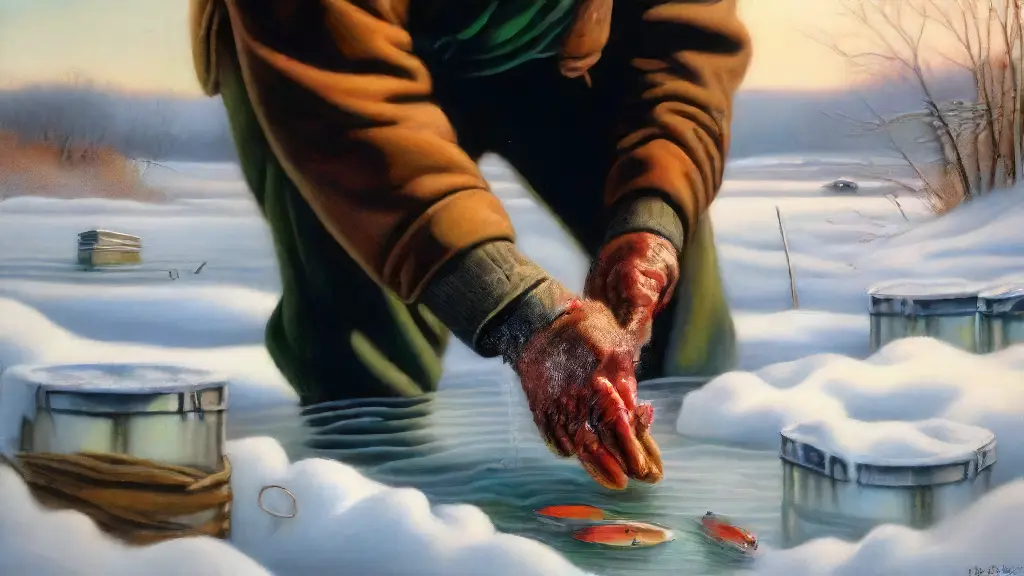How to Handle Live Bait in Cold Weather

Winter fishing offers a unique set of challenges, and one of the most crucial aspects to consider is the care of live baits in cold weather conditions. When temperatures drop, it’s essential to take extra precautions to prevent freezing, which can lead to devastating consequences for both the bait and your fishing trip.
Live baits in extreme cold weather conditions can lead to devastating consequences, including the breakdown of their natural defenses and reduced survival rates.
When live baits freeze, their metabolic processes slow down, and they become more susceptible to disease and stress.
To prevent freezing, it’s crucial to maintain the right aquatic environment, using materials that are coldresistant and equipped with a conservation system. Live bait freezing can have severe consequences if not properly stored in cold-resistant containers for aquatic conservation.
How to Handle Live Bait in Cold Weather
When the mercury drops, anglers must adapt to ensure their favorite hobby remains enjoyable. The key to successful cold weather fishing lies not only in the right gear, but also in understanding the intricate relationships between temperature, humidity, and the delicate balance of aquatic life.
In cold weather fishing, it’s essential to understand the unique challenges of handling live bait.
The importance of proper live bait care cannot be overstated, as even slight neglect can have devastating consequences for the fish and the ecosystem.
When preparing live bait for cold weather conditions, it’s crucial to select the right type of bait for the task at hand. Acclimating live bait to cold temperatures is also vital, as sudden changes can cause stress and compromise the fish’s overall health. between a catch and a failed fishing trip.

Why Bait Goes Bad in Cold
Winter’s chill can be a malign force for fishermen, especially when it comes to their bait’s vitality. As the mercury plummets, the effects of freezing temperatures can quickly render even the freshest catch unappealing to fish.
Facts about Cold Weather and Live Bait Metabolism
Cold temperatures slow down a bait’s metabolism, indicating that they require less food to sustain themselves.
This also means they are less active and more susceptible to stress.
It’s essential for anglers to grasp these changes and adjust their handling techniques accordingly. They should provide their bait with its essential energy needs, possibly through the use of aerated water or the addition of a small amount of a bait-friendly energy supplement.
The Impact of Cold on Bait’s Water Quality
When the water temperature drops, the quality of the water can also be affected. Cold water can hold a few fishers suspended precariously in the freezing, frost-covered waters off the coast.
Choosing the Right Coldresistant Baits
Facing the harsh winter conditions, anglers must prioritize the well-being of their live baits to ensure a successful fishing experience.
Threats to live bait survival in cold weather include reduced metabolic rates, dehydration, and compromised oxygen circulation. Proper handling and care are crucial to mitigate these threats and ensure successful fishing trips.
Understanding Live Bait Physiology in Cold Weather
When temperatures drop, live baits’ metabolic rates slow down, making them more susceptible to dehydration.
In cold water, they absorb water to maintain hydration, but this can lead to swelling and decreased buoyancy.
Oxygen consumption and circulation are impaired, making it essential to maintain optimal water quality and circulation. When selecting cold-resistant baits, consider the habitat and handling requirements to avoid frostbite in your hands, especially in areas with glacial temperatures.
Can You Freeze Bait in Water
How to preserve their catch in the midst of freezing temperatures. Many anglers rely on live bait to land the big one, but the struggle is real to keep these livelier options fresh and healthy throughout the fishing trip.
Facts: Physiological changes in live bait during freezing temperatures
Live bait, such as worms and minnows, can tolerate short-term exposure to icy cold water, but prolonged exposure to hypothermic conditions can significantly slow down their metabolism.
This physiological response ultimately leads to the bait’s demise.
It is crucial to understand the physiological changes that occur when live bait is subjected to freezing temperatures.
Optimal storage conditions for live bait require insulation from the cold.
Inadequate storage can lead to the bait’s demise. When in doubt, it is best to err on the side of caution and stay warm and insulated in icy conditions to avoid the risk of hypothermia, especially during leisure activities.
| Temperature Range (°F) | Physiological Response | Storage Requirements | Consequences |
|---|---|---|---|
| 40-50°F | Short-term tolerance, slow metabolism | Insulation, monitoring | Reduced viability, risk of hypothermia |
| Below 40°F | Prolonged exposure, significant slowdown | Immediate storage, warming | Increased risk of mortality, hypothermia |
| – | – | Proper storage, handling, and monitoring | Optimal bait health, successful fishing trip |
Fish Bait Handling Tips in Cold Weather
Catching fish in cold weather requires a delicate balance of patience, skill, and the right bait. When the water temps dip, fish become sluggish and more finicky, making it essential to handle live bait with extra care.
Proper handling and care of live bait in cold weather conditions are crucial for anglers to ensure the success of their fishing trips.
Cold weather fishing requires a different approach to live bait handling, as the fish’s metabolism slows down, making them less active and more sensitive to their environment.
When preparing live bait for cold weather fishing, it’s essential to choose the right type of bait. Preservation of natural baits such as worms and minnows is more effective in cold water than artificial lures, which often struggle to entice fish. To store live bait in cold conditions, anglers should use proper containers and storage methods to ensure natural preservation outdoors, thereby maintaining a healthy environment for the bait and reducing the need for frequent maintenance.
Preventing Frostbite While Handling Bait
Winter recreation enthusiasts often brave subzero temperatures to enjoy activities like ice fishing and snowmobiling. The harsh conditions can be unforgiving, and it’s crucial to take necessary precautions to avoid frostbite.
Winter Recreation Safety Tips
- Exposure to subzero temperatures can cause frostbite in as little as 30 minutes.
- The risk of frostbite increases with wind speed and humidity, making it essential to dress in layers and cover exposed skin.
- Frostbite can occur on any part of the body, including fingers, toes, ears, and nose, and can be painful and potentially permanent if left untreated.
- It’s crucial to take regular breaks in warm, dry areas to thaw out extremities and prevent further damage.
How to Keep Bait Alive in Freezing Conditions
Preserving the vitality of their bait in the face of freezing temperatures. The secret to success lies in understanding the intricate physiological needs of the species in question, and adopting storage techniques that prioritize their survival.
Bait’s ability to thrive in freezing conditions relies on its capacity to regulate oxygen intake, a process influenced by the individual species’ metabolic rate.
For instance, some fish are adapted to conserve energy by slowing down their metabolism, while others require a steady supply of oxygen to stay alive.
To ensure your bait remains thermally stable, it’s essential to employ proper storage techniques, keeping it away from direct contact with the cold water and using thermoses or insulated containers to maintain a consistent temperature.
Understanding the physiological needs of your bait is paramount to keeping it alive in freezing conditions.
What Happens if Bait Freezes
As the mercury drops and the seasons change, icy grip of winter begins to take hold, anglers face a unique challenge in the pursuit of their catch.
In the wilderness of winter, waterquality and thermal conditions can drastically affect the health and viability of live bait, leading to reduced catch rates and frustrated fishing trips.
As temperatures plummet, anglers often find themselves wrestling with the consequences of frozen bait.
When bait freezes, it can succumb to stress and eventually succumb to death, resulting in a loss of natural behavior and appeal to fish.
Without proper care, bait can become lethargic, its respiration rapid, and its color dulled, making it nearly undetectable to the fish.
Learning to recognize the warning signs of stressed bait is crucial to addressing issues promptly and minimizing damage. By understanding the effects of winter on bait, anglers can take proactive steps to adjust their tactics accordingly, which may include monitoring thermal profiles, water quality fluctuations, and wilderness conditions to improve their chances of success.
Winter’s Impact on Live Bait
- When bait freezes, it can succumb to stress and eventually succumb to death, resulting in a loss of natural behavior and appeal to fish.
- Bait that has frozen can become lethargic, its respiration rapid, and its color dulled, making it nearly undetectable to the fish.
- Stressed bait can result in reduced catch rates and frustrated fishing trips, making it crucial to recognize the warning signs of stressed bait and address issues promptly.
- Understanding the effects of winter on bait allows anglers to take proactive steps to adjust their tactics accordingly, including monitoring thermal profiles, water quality fluctuations, and wilderness conditions to improve their chances of success.
Best Tools for Handling Live Bait
Best Techniques for Hooking Live Bait


